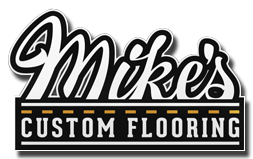When installing hardwood floors, one of the most important decisions you’ll make is which installation method to use. The three primary methods, nail-down, glue-down, and floating, each have their own advantages and best-use scenarios. Choosing the right one depends on your subfloor, the type of hardwood you’re installing, and your long-term flooring goals. We at Mikes Custom Flooring would like to provide a breakdown of each method to help you determine which is best for your home or project.
Nail-Down Installation
Nail-down flooring is the traditional method used for solid hardwood floors. It involves fastening planks to a wooden subfloor using nails or flooring staples.
Best for:
– Solid hardwood flooring
– Homes with plywood or OSB subfloors
– Ground-level or above-grade installations
Pros:
– Provides a very secure and long-lasting hold
– Ideal for thicker, solid wood planks
– Minimal movement or shifting after installation
Cons:
– Not suitable for concrete subfloors
– Requires more time and skill to install
– Can be noisy and dusty due to hammering
If your home has a plywood subfloor and you’re opting for traditional solid hardwood, nail-down is usually the most durable and time-tested method.
Glue-Down Installation
With glue-down installation, hardwood planks are adhered directly to the subfloor using a strong adhesive. This is common with engineered hardwood flooring, especially when installing over concrete.
Best for:
– Engineered hardwood
– Concrete subfloors
– Below-grade installations (like basements)
Pros:
– Ideal for sound insulation and stability
– Works well over concrete and radiant heating
– Minimizes movement and creaks
Cons:
– Can be messy and requires proper ventilation
– Removal is difficult and time-consuming
– More expensive due to glue and labor
This method is excellent for homeowners who want extra soundproofing or are installing floors in areas where moisture may be present, like basements.
Floating Floor Installation
Floating floors are not attached to the subfloor with nails or glue. Instead, the planks are clicked or locked together over an underlayment.
Best for:
– Engineered or laminate flooring
– Quick DIY-friendly projects
– Installations over tile or existing flooring
Pros:
– Fast and easy to install
– No nails or glue required
– Can be installed over almost any surface
Cons:
– Can feel less solid underfoot
– More susceptible to moisture-related issues
– May produce a hollow sound without quality underlayment
Floating floors are great for homeowners who want flexibility and a quick installation without altering the existing floor structure.
Hardwood Floor Installation, Repairs, Refinishing & More in Charles Town & Eastern Panhandle of Berkeley & Jefferson Counties in WV | Winchester & Frederick County | Round Hill & Loudoun County | Berryville & Clarke County | Herndon & Fairfax County VA
There’s no one-size-fits-all answer. If you have a plywood subfloor and are using solid hardwood, nail-down is often best. For concrete subfloors or high-moisture areas, glue-down is ideal. If you’re going for convenience or a DIY approach, floating floors offer flexibility and ease. Before deciding, consider your subfloor, the room’s environment, your budget, and how long you want your flooring to last. Contact the professionals of Mikes Custom Flooring to help ensure the best outcome for your hardwood floor installation.





